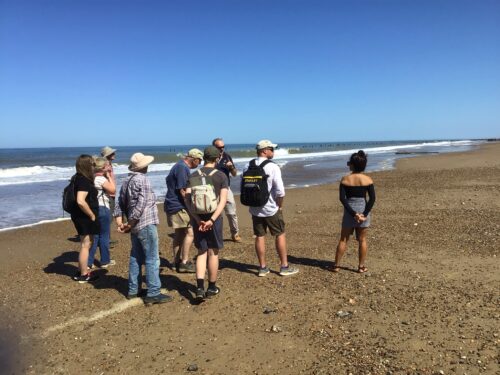Over the weekend of 17th-18th July members of the PAB research team, Dr Claire Harris and Professor Simon Lewis, were once again at Happisburgh to run the Deep History Detectives weekend event. This event was the culmination of a five-month project funded by the Centre for Public Engagement at Queen Mary University of London. Through various sessions, it aimed to provide an opportunity for PAB researchers to meet people who were interested in learning more about the important Palaeolithic sites along the Happisburgh coastline, to share their knowledge and skills with participants, and to encourage them to get involved with the work of the Pathways to Ancient Britain team. Around 40 people attended one or more of the sessions which included a full-day flint knapping workshop, a taster knapping workshop, geological walks on the beach, and training in artefact identification and recording.
The flint knapping workshops and demonstrations were led by experimental archaeologist Dr James Dilley. After an introduction to the basics of flint knapping, the participants were able to get “hands on” and have a go, first to learn how to remove flakes with a hammerstone then, as confidence and proficiency improved, at making a handaxe. Under James’s watchful eye and guidance, all the trainee flint knappers were able to make a handaxe. James also demonstrated other Palaeolithic tool making techniques, including an example of prepared core Levallois working to produce an excellent replica of a Levallois core and flake. The artefact identification session, led by Claire Harris, introduced the participants to the basics of artefact recognition, combining a short practical demonstration, led by James, then transferring this knowledge to look at material collected from the Happisburgh coastline. Participants learnt how to recognise the key features of a humanly-struck flake and how these can be distinguished from either natural percussion or thermally fractured flakes.

For those who wanted to learn more about the geology of the Happisburgh coastline, a geological walk, led by Simon Lewis, introduced the participants to the geological succession that can be seen on the beach at Happisburgh. The unpredictable build-up and removal of sand from Happisburgh beach, conspired to cover up most of the important sediments relating to the archaeological sites at Happisburgh, but it was still possible to tell the story of early humans at Happisburgh and also highlight the importance of on-going work by collectors who visit the area on a regular basis and how this knowledge, when shared with PAB researchers, can add greatly to our understanding of Happisburgh’s archaeological story. There was also the opportunity to discuss the likely impact of movement of material down the coast as a result of the recently-completed Sandscaping project between Walcott and Bacton.
The main aim of the weekend was to provide new knowledge and skills relating to Happisburgh’s Paleolithic story. It is hoped that, armed with this new knowledge and understanding, our Deep History Detectives will continue to visit the area and be better able understand the geological and environmental evidence that can be seen on the beach and to identify and record Palaeolithic artefacts that can contribute to on-going research on the Happisburgh coastline.
